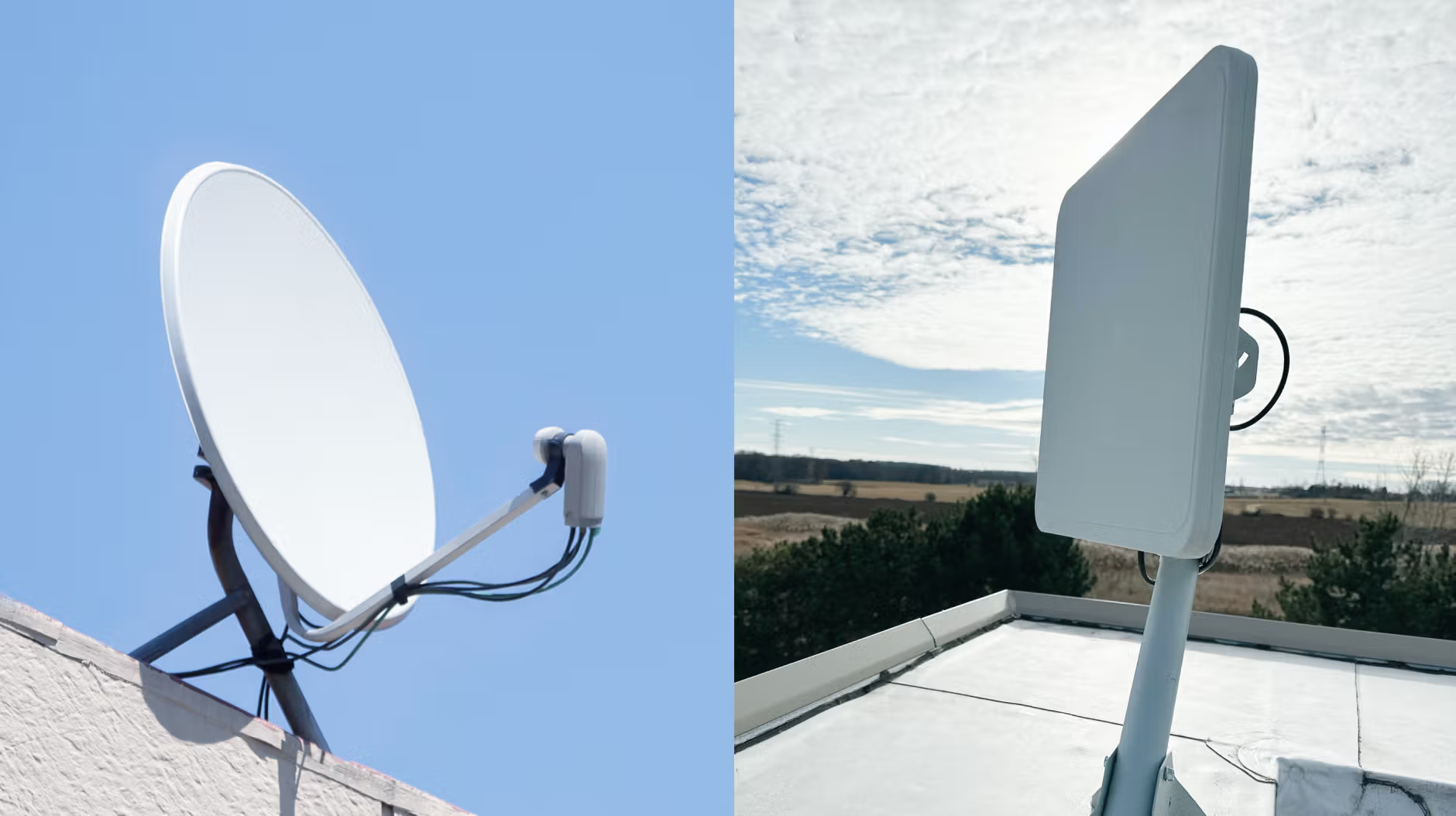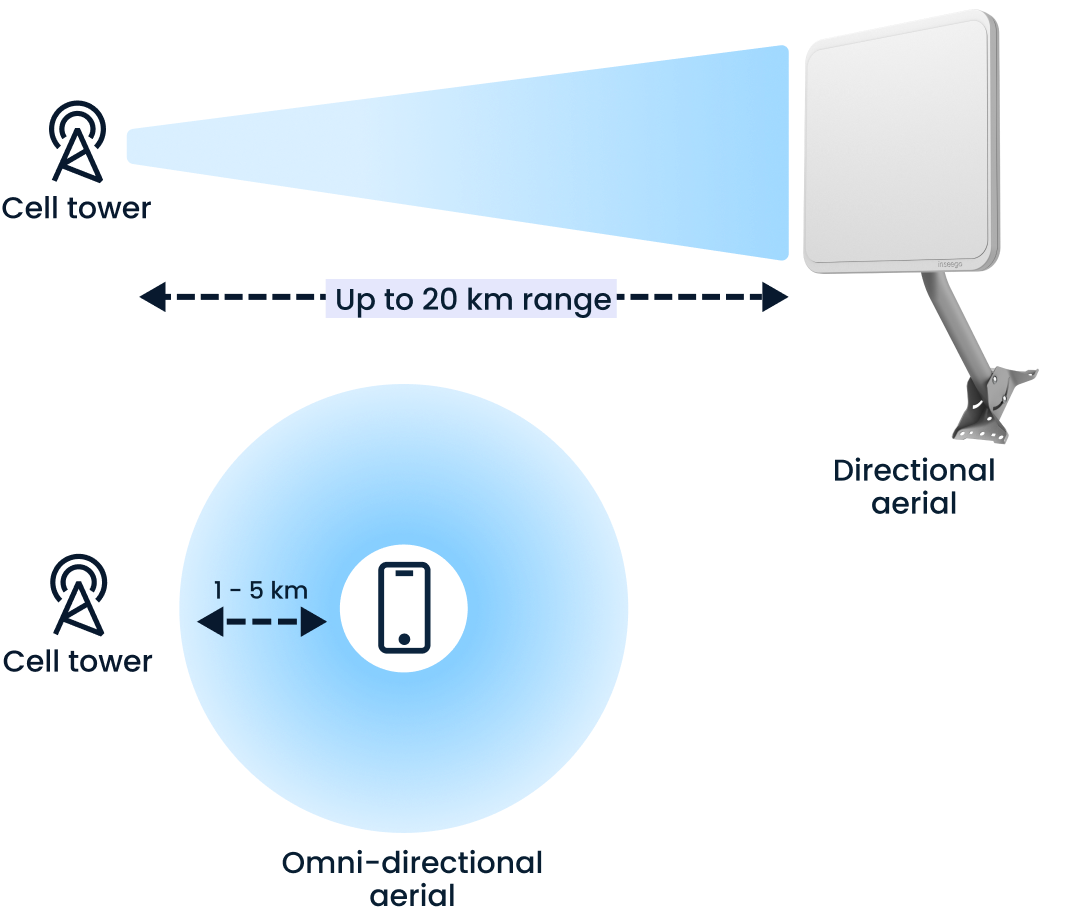Also in this category
View more in Connectivity for Remote NetworksConnectivity for Remote Networks
Cellular vs. Satellite: Why cellular internet is the best choice for rural
Updated on May 6, 2025

Internet connectivity is a significant challenge for rural businesses. Many business-critical operations and devices, including smartphones, tablets, laptops, and even desk computers, rely on this critical infrastructure. Rural businesses must overcome this connectivity challenge in an effective and cost-efficient way.
There are two main technologies competing to bridge this digital divide: satellite internet and cellular internet. But they take substantially different approaches.
To determine which option is the right choice for your business, it’s crucial to understand the primary differences between how these technologies function.
Long-range satellite vs. high-quality cellular
Satellite internet relies on low-orbit or high-orbit satellite networks to provide connectivity to remote locations where traditional infrastructure can’t reach. Ground stations send signals to these satellites, which then relay these signals back to individual devices. Satellite internet offers global coverage but has notable drawbacks in throughput and reliability.
Satellite internet services typically provide maximum download speeds of approximately 12-220 Mbps. Moreover, upload speeds are often significantly lower at around 3-20 Mbps, inhibiting activities like uploading large files or streaming from remote locations. The inherent latency in satellite systems, where long-distance signals must travel from earth to satellite and back, can reach up to 600 milliseconds. This latency can severely impact the performance of real-time, high-bandwidth applications like video calls, online gaming, and Internet of Things (IoT) devices.
Cellular internet’s use of cell towers and cellular networks delivers robust connectivity. Current 5G networks can often deliver download speeds of up to 1000 Mbps, with upload speeds ranging from 10 Mbps to 75 Mbps. This speed is crucial to enabling bandwidth-intensive activities such as remote work, e-learning, and Industrial IoT (IIoT) applications.
Cellular provides reliability during inclement weather
Reliability and consistency are critical considerations when choosing an internet service. Satellite systems are highly susceptible to weather-related disruptions. Heavy rain, snow, or even dense cloud cover can interfere with the signal between the satellite dish and the satellite in orbit. These disruptions can be particularly detrimental in emergency situations.
Cellular networks are largely resilient to adverse weather conditions. The robust infrastructure of cell towers ensures that connectivity remains consistent. Furthermore, advancements in cellular technology, such as beamforming in 5G, further enhance signal strength and reliability, minimizing outages or interruptions.
Satellite requires complex and expensive setup
Deploying satellite internet typically involves setting up large satellite dishes and aligning them with satellites in orbit. This intricate installation process requires precise positioning by professional technicians to ensure a clear line of sight to the satellite, making the process both slow and expensive. Additionally, the installation may require drilling holes for cable routing and mounting the dish on a roof or a sturdy pole, which can be cumbersome and invasive to the property.
Cellular internet systems are typically simpler and quicker to install. Antennas are compact and can be easily mounted on walls, roofs, or even windows using minimal tools. Many antennas and routers are designed for plug-and-play installation, allowing users to set them up without professional assistance, and usually come with apps that help users find locations with the best service. This user-friendly approach saves time and reduces installation costs.
Cellular is more cost-effective
The upfront costs for installing satellite internet can be a significant barrier. Satellite internet typically requires professional installation and the purchase of specialized equipment such as large satellite dishes and additional mounting accessories to secure the dish. This equipment can run into hundreds or even thousands of dollars, depending on the provider and the required installation complexity. On-site installation adds costs as well. While cellular routers and antennas also require an initial investment, costs are generally similar or lower and come with more long-term benefits and an enhanced return-on-investment (ROI).
Lower maintenance costs and more consistent performance of cellular internet are also important factors. Cellular services are more resilient to weather conditions. They provide steady and dependable connectivity, minimizing downtime and ensuring that users get more continuous value for their initial investment. Proactive network management, including the deployment of additional cell towers and small cells to enhance coverage and capacity in underserved areas, will continue to provide value into the future.
Another advantage of cellular internet is its adaptability to technological advancements. The technology is constantly evolving, ensuring users benefit from speed and latency improvements and enhanced features without needing to overhaul their existing setups. Software updates and network optimizations are often managed remotely by the service provider or through an app, ensuring that the system remains up to date without requiring user intervention. Upgrading to newer technology generally involves simple firmware updates or swapping out hardware components, which is far less invasive and costly than upgrading satellite systems.
Inseego offers industry-leading outdoor cellular antennas
Our outdoor cellular antennas are designed to provide fast and reliable connectivity in remote locations. They are FCC-approved, ensuring compliance and robust connectivity without interference. Engineered to withstand harsh environmental conditions with an IP67 rating, these antennas deliver consistent performance regardless of weather. Their rugged design and high-quality materials ensure longevity and durability, making them a cost-effective solution for long-term deployment.
Engineered to support multiple frequency bands and multiple SIM cards, our antennas are compatible with most cellular networks in the United States, supporting speeds up to 1000 Mbps. Additionally, they come with various mounting options, catering to different installation scenarios — from rooftops to poles — ensuring optimal placement for maximum signal reception.
Our antennas are easy to install with Power-over-Ethernet, requiring only one cable for the entire device. They require minimal maintenance and come with remote management software via Inseego Connect. This app allows users to monitor and manage their antennas from anywhere, offering features such as real-time performance metrics, firmware updates, and troubleshooting tools. This added convenience makes them an ideal choice for both residential and commercial use, ensuring reliable connectivity with minimal effort.
To learn more about our innovative outdoor cellular antenna solutions and how they can benefit your connectivity needs:
Talk to our experts!
Set your customers or business up with the fastest, most secure, easiest, most reliable fixed wireless solutions.
Is your current internet connection meeting your business needs?
Even though your current connection is meeting your needs 5G cellular is also an affordable way to provide a back-up internet connection if your primary connection goes down.
Inseego outdoor antennas can support dual SIM cards for multi-carrier failover and ultimate reliability.
How is your connection letting you down?
What is your current connection type?
Do you get cell signal at your business?
Who is your current network provider
We've got a solution
A 5G cellular connection is a great way provide extra resilience to you business. This means if your primary connection goes down, any part of your business that relies on connectivity can carry on uninterrupted.
Even if you get a weak or almost no signal from your mobile phone, you can still get a great connection thanks to the powerful, directional antenna inside the FW2000.
5G cellular plans are affordable, with internet options from $50 - $100 per month, from the leading network providers.
What are your details?
How can we contact you?
Thanks, we've got your request
We’re excited to share our 5G connectivity solutions with you.
Check your email now for a confirmation message. Then a member of our team will send a personalised message within 1 business day to arrange a suitable time to have an in-depth one on one consultation.

5G Outdoor FW2000



Did you know?


5G Outdoor FW2000


Did you know?
Our hugely experienced team are located across the USA.
We’ll connect you with the Inseego team member nearest to you.
What happens next?
We aim to contact you via email within 1 business day to arrange a suitable to time for a detailed discussion of your needs.

